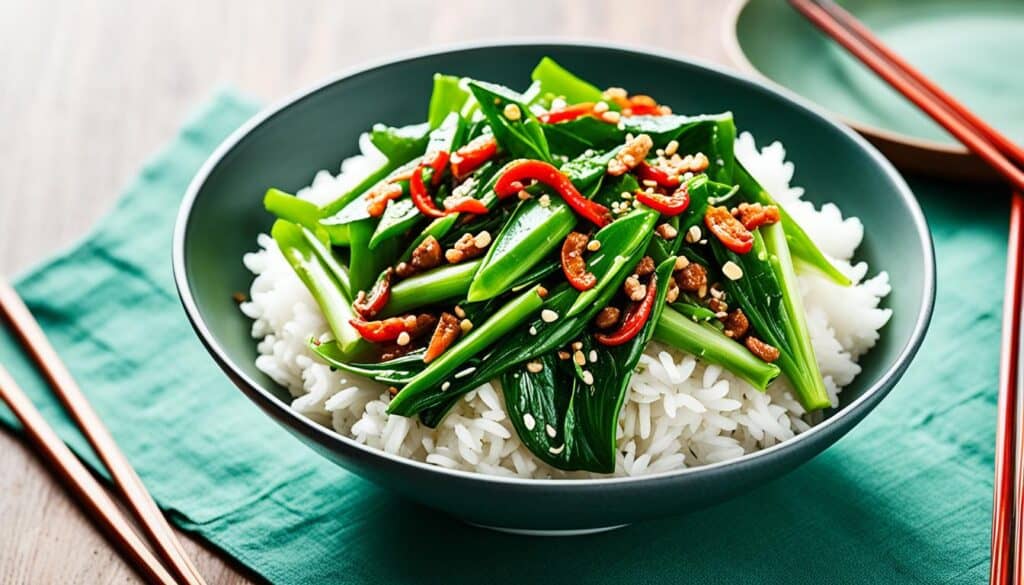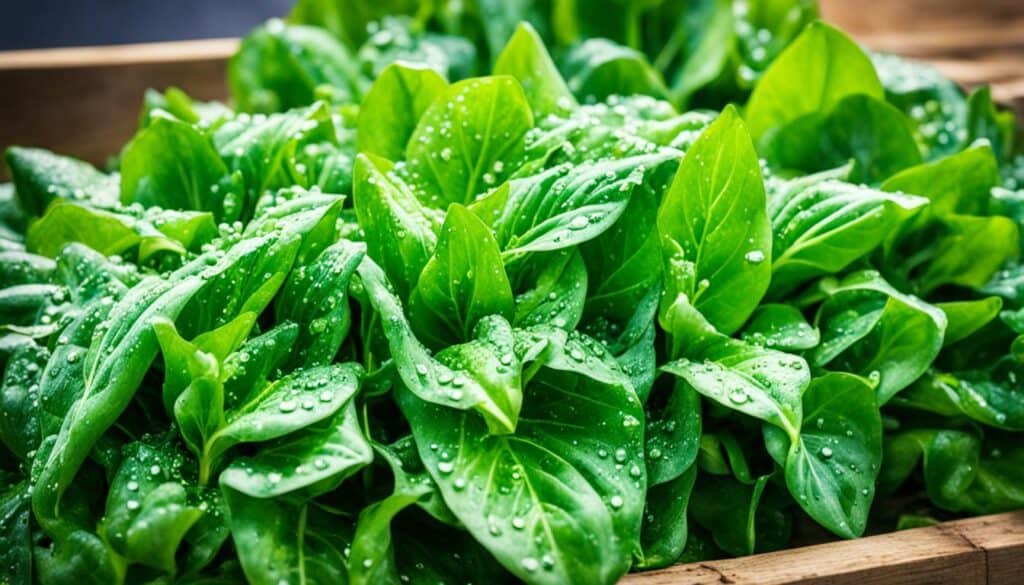Did you know that ong choy, also known as Chinese water spinach or kangkong, is one of the most widely consumed leafy greens in Asia?
In this article, I will share some of my favorite recipes featuring ong choy. From simple stir-fried dishes to more complex preparations with XO sauce, these recipes will showcase the delicious flavors of this nutrient-rich vegetable. Get ready to discover new ways to enjoy ong choy and add a vibrant twist to your meals!
Key Takeaways:
- Ong choy, also known as Chinese water spinach or kangkong, is a versatile leafy green popular in Asian cuisine.
- Stir-fried ong choy with garlic and fish sauce is a simple and flavorful recipe.
- Try incorporating a fermented bean curd sauce or pairing ong choy with XO sauce for more delicious variations.
- Ong choy goes by different names across regions, but it refers to the same leafy green vegetable.
- Look for fresh ong choy at Chinese supermarkets or in specialty produce markets.
Stir-Fried Ong Choy with Garlic and Fish Sauce
One of the most popular ways to prepare ong choy is by stir-frying it with garlic and fish sauce. This simple recipe requires just three ingredients: ong choy, garlic, and fish sauce.
The preparation starts by sautéing the ong choy stems to bring out their natural flavors. Then, the vibrant green leaves are added to the pan, giving the dish a beautiful pop of color. As the ong choy cooks, its stems become tender-crisp, providing a satisfying crunch with every bite.
Once the ong choy is cooked to perfection, it’s time to season it with fish sauce. This umami-rich condiment adds depth and a savory taste to the stir-fried dish. The combination of garlic and fish sauce creates a harmonious flavor profile that complements the natural sweetness of the ong choy.
Stir-fried ong choy with garlic and fish sauce can be served as a delightful vegetable side dish or as a main course when paired with rice or noodles. Its simplicity allows the vibrant flavors of the ong choy to shine through, making it a favorite among both novice and experienced home cooks.
I absolutely adore this stir-fried ong choy recipe. The combination of garlic and fish sauce gives the dish a burst of flavors that enhances the natural taste of the vegetable. Plus, the crunch from the tender-crisp stems adds an enjoyable texture to every bite. It’s an easy and satisfying dish that I keep coming back to.
Ong Choy with Fermented Bean Curd Sauce
Another delicious way to enjoy the versatility of ong choy is by incorporating a savory fermented bean curd sauce. This flavorful recipe calls for mashing the fermented bean curd with water to create a rich and aromatic sauce. The ong choy is then stir-fried with garlic to enhance its natural flavors. Finally, the tender leaves and crunchy stems are tossed in the sauce, resulting in a dish that is both satisfying and nutritious.
Stir-frying ong choy with fermented bean curd sauce is a popular method in Asian cuisine, as it brings together the umami taste of the bean curd and the fresh, vibrant flavors of the leafy green. The sauce adds a depth of flavor that complements the natural sweetness and slight bitterness of the vegetable.
To prepare this delightful dish, start by washing the ong choy thoroughly and separating the leaves from the stems. Mince some garlic and heat it in a wok or a large skillet with some oil. Once the garlic becomes fragrant and slightly golden, add the ong choy stems and stir-fry them until they become tender. Then, add the leaves and continue stir-frying until they wilt down.
In a small bowl, mash the fermented bean curd with water to create a smooth sauce. The amount of water added can be adjusted based on personal preference for a thicker or thinner sauce. Pour the sauce over the stir-fried ong choy and toss everything together until the vegetable is evenly coated.
This delightful dish can be enjoyed as a side dish or as a main course served with steamed rice or noodles. The combination of the tangy, slightly salty fermented bean curd sauce with the crispiness of the ong choy stems and the tenderness of the leaves creates a delightful textural contrast that will please your taste buds.
Benefits of Fermented Bean Curd
Fermented bean curd, also known as tofu cheese, is a popular ingredient in Chinese cuisine. It is made by fermenting tofu in a mixture of rice wine, salt, and other seasonings. This fermentation process creates a unique flavor that is both savory and slightly tangy.
Fermented bean curd is not only delicious but also offers numerous health benefits. It is a good source of protein and contains essential amino acids that are necessary for the body’s growth and development. Additionally, it is rich in calcium, iron, and other minerals that contribute to overall bone health.
This fermented ingredient also contains probiotics, which are beneficial bacteria that support gut health and digestion. Probiotics help maintain a healthy balance of bacteria in the digestive system, which can improve digestion and nutrient absorption. Furthermore, fermented bean curd is low in calories and fat, making it a good choice for those following a healthy eating plan.
With its unique flavor and nutritional benefits, fermented bean curd adds an extra layer of complexity and depth to various dishes, including the well-loved ong choy stir-fry.
| Ingredients | Instructions |
|---|---|
|
|
Ong Choy with XO Sauce
For a more indulgent preparation, try pairing ong choy with XO sauce. XO sauce is a luxurious condiment made from dried seafood and spices. In this recipe, the ong choy is stir-fried with ginger, garlic, and XO sauce, resulting in a dish that is savory and packed with umami flavors. This combination elevates the humble ong choy to a whole new level.
Indulge in Savory Delights
If you’re looking to take your ong choy dish to the next level, XO sauce is the perfect companion. Made from a blend of dried seafood, including scallops and shrimp, combined with aromatic spices, XO sauce adds a depth of flavor and complexity that enhances every bite. The umami-rich sauce brings out the natural sweetness of the ong choy, creating a harmonious balance of flavors.
A Versatile Ingredient
XO sauce can be used in a variety of dishes, from stir-fries to noodles, as well as a condiment for dipping or marinades. Its luxurious and intense flavor profile adds a touch of sophistication to any meal. Whether you’re a fan of spicy or mild flavors, XO sauce can be adjusted to suit your taste preferences, allowing you to customize your ong choy dish to perfection.
I love the combination of ong choy and XO sauce. The richness of the sauce perfectly complements the fresh and tender texture of the ong choy. It’s a match made in culinary heaven!
How to Prepare Ong Choy with XO Sauce
To make this delicious dish, begin by cleaning and trimming the ong choy, removing any tough or damaged parts. Heat a wok or skillet over medium-high heat and add some oil. Stir-fry the ginger and garlic until fragrant, then add the ong choy and stir-fry for a few minutes until wilted. Finally, add the XO sauce and toss everything together until well coated. Serve hot and enjoy!
Experience the Elevated Flavors
Indulge in the tantalizing flavors of ong choy with XO sauce. This combination of Chinese leafy greens and a luxurious condiment will take your taste buds on a culinary adventure. Elevate your dining experience with this savory and satisfying dish.
Various Names and Varieties of Ong Choy
Ong choy, also known as Chinese water spinach or kangkong, is a versatile leafy green vegetable that is popular in Asian cuisine. It is loved for its tender leaves and long hollow stems, which give it a unique and satisfying crunch. Despite its different names, ong choy refers to the same leafy green vegetable and is part of the morning glory family.
Here are some of the various names for ong choy:
| Name | Language |
|---|---|
| Ong Choy | Cantonese |
| Kong Xin Cai | Mandarin |
| Rau Muong | Vietnamese |
| Kangkong | Malaysia, Southeast Asia |
Regardless of the name, the delicious taste and versatility of ong choy remain the same. Whether you call it ong choy, Chinese water spinach, kangkong, or morning glory, this leafy green vegetable is a nutritious and flavorful addition to any meal.
Where to Find Fresh Ong Choy
Fresh ong choy, also known as Chinese water spinach or kangkong, can be easily sourced at Chinese supermarkets or specialty produce markets. If you happen to be in Honolulu, Chinatown is a fantastic place to discover beautiful and fresh ong choy. To ensure the best quality, it’s essential to wash the stems thoroughly before cooking, as they can sometimes collect dirt due to their hollow nature. Look for vibrant green bunches with crisp stems, indicating freshness and optimal flavor.
When it comes to finding fresh ong choy, Chinese supermarkets are particularly reliable due to their focus on Asian produce. These establishments understand the significance of ong choy in Asian cuisine and often stock it accordingly. Additionally, specialty produce markets that cater to a diverse range of international ingredients may also carry fresh ong choy. These markets provide a wider selection of unique and traditional produce, ensuring that you’ll find the freshest ong choy for your culinary endeavors.
Chinatown in Honolulu, Hawaii, is regarded as a hub for Asian culture and cuisine. With its vibrant atmosphere and numerous Asian markets, it’s no surprise that Chinatown is a go-to destination for finding fresh ong choy. The close proximity to local farms and the rich Asian cultural influence make it an ideal location to explore and purchase the finest quality ong choy.
When selecting fresh ong choy, it’s crucial to consider its visual appearance. Vibrant green leaves and firm, crisp stems are indicators of freshness. Avoid ong choy with wilted or yellowing leaves, as these signs may indicate that the vegetable is past its prime. By choosing the highest-quality ong choy, you can ensure a delightful dining experience packed with vibrant flavors and nutritious benefits.
The Best Part of Ong Choy: Sweet Stalks and Crunchy Texture
The best part of ong choy is its sweet stalks and crunchy texture. The hollow stems give ong choy its signature crunch, making it a delight to eat. When preparing ong choy, it’s important to cut off the tough bottom portion of the stems and wash them thoroughly to remove any dirt or grit. The remaining stems and leaves are then cooked to perfection, resulting in a dish that is both visually appealing and delicious.
If you’re looking for a nutritious and flavorful vegetable, ong choy is an excellent choice. Its hollow stems provide a satisfying crunch, while the sweet taste adds a refreshing element to any meal. Whether stir-fried with garlic and fish sauce or paired with XO sauce for an indulgent treat, ong choy is a versatile ingredient that complements a variety of flavors. Its vibrant green color and crunchy texture make it not only a favorite among health-conscious individuals but also a visually appealing addition to any dish.
To fully enjoy the unique qualities of ong choy, it’s important to properly prepare and cook it. By trimming the tough bottom portion of the stems and washing them thoroughly, you can ensure a clean and grit-free vegetable. Cooking the remaining stems and leaves to the right level of tenderness will bring out the best of ong choy’s sweet stalks and crunchy texture. Whether you’re a fan of simple stir-fries or more complex preparations, ong choy is sure to satisfy your palate with its delightful crunch and natural sweetness.
Next, let’s explore the various names and varieties of ong choy, as well as where to find fresh ong choy for your culinary adventures.
Popular Chinese Leafy Greens
Ong choy is just one of the many popular Chinese leafy greens available. Other commonly used options include Chinese broccoli, choy sum, spinach, Shanghai bok choy, and pea leaves. These vegetables are often served stir-fried with various flavorings, such as garlic paste, fermented bean curd, or fish sauce, allowing for a wide range of taste experiences.
| Chinese Leafy Greens | Description |
|---|---|
| Chinese Broccoli | A leafy green vegetable with thick stems and dark green leaves. It has a slightly bitter taste and a crunchy texture. |
| Choy Sum | Also known as Chinese flowering cabbage, choy sum has tender leaves and thin stems. It has a mild, slightly sweet flavor. |
| Spinach | A versatile leafy green vegetable with tender leaves and a mild flavor. Spinach can be eaten raw in salads or cooked in various dishes. |
| Shanghai Bok Choy | Similar to regular bok choy, Shanghai bok choy has tender leaves and crisp stems. It has a mild, slightly sweet taste. |
| Pea Leaves | The tender shoots and leaves of pea plants. They have a delicate flavor and are often used in stir-fries and soups. |
Discover the Taste of Chinese Leafy Greens
Chinese leafy greens offer a variety of flavors and textures when cooked. Here are some examples:
- Chinese broccoli: Its slightly bitter taste pairs well with oyster sauce or garlic sauce.
- Choy sum: Its mild sweetness shines when stir-fried with garlic and a splash of soy sauce.
- Spinach: Its tender leaves can be blanched and seasoned with sesame oil and a sprinkle of toasted sesame seeds.
- Shanghai bok choy: Its crisp stems can be stir-fried with ginger and garlic for a simple yet delicious dish.
- Pea leaves: They are excellent when stir-fried with minced garlic and a touch of chicken broth.
Explore the vibrant flavors of Chinese leafy greens in your next culinary adventure.
Note: The provided image showcases a variety of Chinese leafy greens, including ong choy, Chinese broccoli, choy sum, and Shanghai bok choy.
Making Your Own XO Sauce
XO sauce is a key ingredient in one of the recipe variations mentioned earlier. While it can be expensive to purchase, making your own XO sauce at home is a cost-effective option. With just a few ingredients and a little bit of time, you can create a big batch of this flavorful condiment to use in your dishes.
To help you get started, here’s a simple homemade XO sauce recipe:
Homemade XO Sauce Recipe
- Ingredients:
- 1 cup dried scallops
- 1 cup dried shrimp
- 1 cup Chinese cured ham, finely diced
- 10 cloves garlic, minced
- 2 shallots, minced
- 2 tablespoons dried chili flakes
- 1 cup vegetable oil
- 1 tablespoon sugar
- 2 tablespoons fish sauce
- Instructions:
- Soak the dried scallops and dried shrimp in warm water for about 30 minutes until softened. Drain and finely chop.
- In a skillet over medium heat, add the vegetable oil and heat until hot. Add the garlic, shallots, and dried chili flakes, and sauté until fragrant.
- Add the dried scallops, dried shrimp, and Chinese cured ham to the skillet. Cook, stirring occasionally, until the ingredients are well combined and fragrant.
- Reduce the heat to low and add the sugar and fish sauce. Stir well to coat the ingredients.
- Cook the mixture for another 10-15 minutes, stirring occasionally, until the sauce thickens and the flavors meld together.
- Remove the skillet from heat and let the XO sauce cool completely.
- Transfer the XO sauce to a clean, airtight jar and store it in the refrigerator for up to 6 months.
Enjoying Homemade XO Sauce
With your homemade XO sauce ready, you can now enhance the flavors of your ong choy dishes and other Asian-inspired meals. Whether you use it as a finishing touch, a dipping sauce, or as a base for stir-fries, XO sauce adds a deep umami flavor and a touch of luxury to your culinary creations.
Conclusion
Ong choy is a versatile leafy green that can be prepared in various ways. Whether you prefer the simplicity of stir-frying with garlic and fish sauce or the indulgence of pairing it with XO sauce, ong choy offers a range of flavors and textures to enjoy. Experiment with different recipes and preparations to discover your favorite way to enjoy this nutritious and delicious leafy green.
From the tender and sweet stalks to the satisfying crunch of its hollow stems, ong choy is a delightful addition to any meal. Its vibrant green color and nutritious profile make it a popular choice for those looking to incorporate more leafy greens into their diet. Whether you’re a seasoned chef or a beginner in the kitchen, ong choy is a versatile ingredient that can be easily incorporated into a variety of dishes.
So go ahead and explore the wonderful world of ong choy! Try out the recipes mentioned earlier or create your own unique dishes. With its fresh and vibrant taste, ong choy is sure to add a burst of flavor to your meals. Enjoy the delicious flavors and health benefits that this leafy green has to offer. Get creative and make ong choy a staple in your leafy green recipes!










Leave a Reply